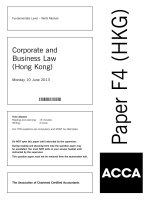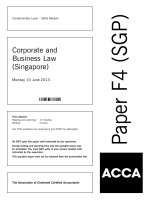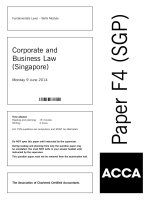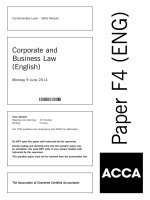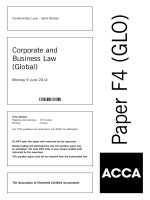Acca f4 corporate and business law singapore 2014 jun answer
Bạn đang xem bản rút gọn của tài liệu. Xem và tải ngay bản đầy đủ của tài liệu tại đây (247.98 KB, 9 trang )
Answers
Fundamentals Level – Skills Module, Paper F4 (SGP)
Corporate and Business Law (Singapore)
1
2
June 2014 Answers
(a)
According to the literal rule, the literal meaning of words in a statute is to be given effect. The literal rule of statutory
interpretation should be the first rule applied by judges. Under the literal rule, the words of the statute are given their natural
or ordinary meaning and applied without the judge seeking to put a gloss on the words or seek to make sense of the statute.
In R v Harris (1836), the defendant bit off his victim’s nose. The statute made it an offence ‘to stab, cut or wound’. The court
held that under the literal rule, the act of biting did not come within the meaning of stab, cut or wound as these words implied
an instrument had to be used. Therefore the defendant’s conviction was quashed.
(b)
The ejusdem generis rule applies so that general words following specific words should be read as being in the same group
as the specific words. In Knott v Blackburn (1944), the statute provided that a person found in or upon ‘any dwelling house,
warehouse, coach-house, stable or outhouse, or in any enclosed yard, garden or area’ for any unlawful purpose shall be
deemed to be a rogue and vagabond. The court held that ‘area’ must be construed ejusdem generis with the preceding words,
and was a space akin to a yard or garden. Railway sidings were not included in the word ‘area’.
(c)
The golden rule requires a provision in a statute to be construed in accordance with the plain meaning of the words unless
it gives rise to an absurd result. The golden rule qualifies the literal rule in that the literal rule is not to be applied where doing
so will lead to absurdity or injustice. In R v Allen (1872), the statute stated that ‘whosoever being married shall marry any
other person during the lifetime of the former husband or wife is guilty of an offence’. Under a literal interpretation of this
section, the offence would be impossible to commit since civil law will not recognise a second marriage. Thus any attempt
to marry in such circumstances would not be recognised as a valid marriage. The court applied the golden rule and held that
the word ‘marry’ should be interpreted as ‘to go through a marriage ceremony’. The defendant’s conviction was upheld.
(d)
The mischief rule is applied in situations where there is an ambiguity in the meaning of the words in a statute. When using
the mischief rule, the court interprets the statute by considering the common law position prior to the passing of the statute,
the mischief or defect for which the common law did not provide, and the remedy the Parliament resolved to cure the defect.
In Elliot v Grey (1960), the defendant’s car was parked on the road. It was jacked up and had its battery removed. The
defendant was charged with an offence under the Road Traffic Act 1930 of using an uninsured vehicle on the road. The
defendant argued he was not ‘using’ the car on the road as it clearly was not driveable. The court applied the mischief rule
and held that the car was being used on the road as it represented a hazard and therefore insurance would be required in
the event of an incident. The statute was aimed at ensuring people were compensated when injured due to the hazards
created by others.
(a)
An exclusion clause may become a term of the contract by signature or by notice.
(i)
Signature
If a person signs a contractual document they are bound by its terms, including any exclusion clause it may contain,
even if they do not read the document. In L’Estrange v Graucob (1934) the plaintiff, who was a café proprietress, bought
a vending machine. She signed, without reading it, a sales agreement which contained a number of clauses ‘in
regrettably small print but quite legible’. The machine did not work properly. The defendants were held to be protected
by a clause which excluded their liability.
(ii)
Notice
If a contractual document is not signed, the question of notice arises. The exclusion clause may be printed on a
document which is handed to one party by the other or is posted up in the shop or booking hall or other place where
the contract is made. In such a case the clause will only be incorporated into the contract, so as to become a term of
it, if:
(1) the party affected knows of the clause, or
(2) reasonable steps are taken to bring it to his notice.
(b)
Liability (i.e. business liability) for death or personal injury resulting from negligence cannot be excluded or restricted by any
contract term or notice: s.2(1) Unfair Contract Terms Act (Cap 396) (‘UCTA’).
(c)
In the case of other loss or damage (i.e. not death or personal injury), a person cannot so exclude or restrict his (business)
liability for negligence in so far as the term or notice satisfies the requirement of reasonableness: s.2(2) UCTA. The
requirement of reasonableness ‘is that the term shall have been a fair and reasonable one to be included having regard to the
circumstances which were, or ought reasonably to have been, known to or in the contemplation of the parties when the
contract was made’: s.11(1) UCTA.
Guidelines for the application of the reasonableness test are laid down in the Second Schedule to s.11(2) UCTA. They include:
–
If the parties have equal bargaining strengths, it is likely that they could have negotiated the terms and so the exclusion
clause is likely to be considered to be reasonable.
–
Whether the customer received an inducement to agree to the term.
7
3
(a)
–
Whether the customer knew or ought to know about the exclusion clause.
–
If the exclusion clause states that the business will only be liable if there is compliance with some condition, then
whether compliance with that condition was reasonably practicable.
–
Whether the goods were manufactured, processed or adapted to the special order of the customer.
Similarities may include any three of the following:
–
A limited liability partnership (‘LLP’) gives owners the flexibility of operating as a partnership while having a separate
legal identity, like a company. This means that the LLP and company are each a body corporate, which has a legal
personality separate from its partners/members and directors (s.4 LLP Act and s.19(5) Companies Act respectively).
–
An LLP and a company enjoy perpetual succession, which means any change in the partners of an LLP/members and
directors of a company will not affect its existence, rights or liabilities.
–
An LLP and a company can sue and be sued in its name.
–
An LLP and a company may acquire and hold property in its name.
–
An LLP and a company may contract using a common seal in its name.
–
Like shareholders and directors in a company, who will not be held personally liable for business debts incurred by the
company, the partners of the LLP will not be held personally liable for any business debts incurred by the LLP (Salomon
v A Salomon & Co (1897) and s.8 LLP Act respectively).
–
An LLP and a company are required to keep accounting records, profit and loss accounts and balance sheets which will
sufficiently explain the transactions and financial position of the LLP and company (s.25 LLP Act and s.201 Companies
Act respectively).
Note: Only three similarities were required.
(b)
Differences may include the following:
–
An LLP is similar to a partnership in that every partner of a limited liability partnership is the agent of the limited liability
partnership (s.9(1) LLP Act). The act of a partner in the ordinary course of business binds the LLP. For a company, the
board typically acts collectively. An individual director does not have authority to bind the company unless he is
authorised by the board to do so (Panorama Developments Ltd v Fidelis Furnishing Fabrics Ltd (1971)).
–
In terms of internal management, an LLP is usually run like a partnership (s.10 LLP Act). The business of the company
will be managed by the directors (s.157A Companies Act). The LLP might therefore be preferable to the company in
certain situations – in particular, where organisational flexibility is desired over centralised management.
–
While both have separate legal personality, the owner–management divide is central to the company but the
owner–management divide does not usually feature in an LLP.
–
For income tax purposes, an LLP will be treated as a partnership and not as a separate legal entity. This means that an
LLP will not be liable to tax at the entity level. Instead, each partner will be taxed on his or its share of the income from
the LLP. Where the partner is an individual, his share of income from the LLP will be taxed based on his personal income
tax rate. Where a partner is a company, its share of income from the LLP will be taxed at the tax rate for companies.
The company, in contrast, will be taxed as an entity, based on the prevailing corporate tax rates.
Note: Only two differences were required.
4
(a)
It is necessary to ascertain if what is being proposed is an alteration of class rights. The law draws a distinction between a
variation of class rights and a variation in the enjoyment of class rights. Examples of variation of class rights include variation
of the modification of rights clause (s.74(7) Companies Act (Cap 50)), the issue by a company of preference shares ranking
pari passu with existing preference shares (s.74(6) Companies Act (Cap 50)). An example of a variation of enjoyment of class
rights may include raising the rate of preference dividend from, say, 6% to 8%, which although will diminish the residual
profits available for distribution to the ordinary shareholders, yet would not be a variation of the rights of ordinary shareholders.
Where what is being proposed is a variation of class rights, the modification of rights clause will have to be complied with.
For example, the modification of rights clause in article 4 of Table A provides that 75% of the holders of the class have to
consent to a variation of class rights.
After the procedure set out in the modification of clause has been complied with, the company has to call a general meeting
to pass a special resolution to amend the article setting out the class rights pursuant to s.37 Companies Act (Cap 50).
(b)
There are two sets of procedures to effect a reduction of capital, namely the method which requires a court order (s.78G-I
Companies Act (Cap 50)) and the method which does not require a court order (s.78B-F Companies Act (Cap 50)).
Court sanctioned capital reduction
–
The company has to pass a special resolution approving the reduction.
8
–
The reduction has to be confirmed by the court. Before the court confirms, it will settle the list of qualifying creditors.
The court will confirm only if it is satisfied that the creditor’s claim is discharged or he has consented to the reduction
or the claim has been secured or the company has a lot of assets left after the reduction.
–
The company has to lodge the court order with the Accounting and Corporate Regulatory Authority.
Non-court sanctioned capital reduction
5
(a)
–
The company has to pass a special resolution approving the reduction.
–
Every director of the company has to make a declaration of solvency.
–
Any creditor may apply to court, within six weeks’ of the passing of the special resolution, to have the resolution
cancelled. The court may cancel the resolution if the creditor’s debt is not secured or there are no safeguards for the
creditor’s debt and it is not the case that safeguards are unnecessary.
Appointment of auditor and statutory duties
The directors of every company must appoint one or more auditors for the company within three months of its incorporation:
s.205(1) Companies Act (Cap 50). A dormant company or an exempt private company with revenue below a prescribed
amount need not have its accounts audited. An auditor must consent to the appointment: s.10(10) Companies Act (Cap 50).
An auditor holds office until the next annual general meeting, at which point the members are expected to re-appoint the
auditor or appoint a new one: s.205(2) Companies Act (Cap 50).
An auditor has two main statutory duties:
(b)
–
If an auditor finds that there has been non-compliance with the Companies Act and the matter cannot be dealt with
adequately through their comments in the audit report or by bringing the matter to the attention of the directors, they
are obliged to report the matter to the Registrar of Companies: s.207(9) Companies Act (Cap 50).
–
If an auditor of a public company or its subsidiary believes that a serious offence involving fraud or dishonesty has been
committed by the company’s officers or employees, they are obliged to report the matter to the Minister or the Monetary
Authority of Singapore: s.207(9A) and (9C) Companies Act (Cap 50).
Appointment of audit committee and functions
Every listed company in Singapore must have an audit committee: s.201B(1) Companies Act (Cap 50). The audit committee
is appointed by the board of directors. It comprises at least three directors, a majority of whom are not to be executive directors
of the company or of a related company or relatives of such executive directors. A member of the audit committee must be
in a position to exercise an independent judgement in carrying out their responsibilities on the committee: s.201B(2)
Companies Act (Cap 50).
According to s.201B(5) Companies Act, the functions of an audit committee include:
(a)
to review –
(i)
(ii)
(iii)
(iv)
(v)
(vi)
(b)
6
(a)
with the auditor, the audit plan;
with the auditor, his evaluation of the system of internal accounting controls;
with the auditor, his audit report;
the assistance given by the company’s officers to the auditor;
the scope and results of the internal audit procedures; and
the balance sheet and profit and loss account of the company and, if it is a holding company, the consolidated
balance sheet and profit and loss account, submitted to it by the company or the holding company, and thereafter
to submit them to the directors of the company or the holding company; and
to nominate a person or persons as auditor, notwithstanding anything contained in the articles or under s.205.
Section 216A Companies Act (Cap 50)
The member may bring a ‘derivative’ action in the company’s name to enforce the company’s rights. Section 216A Companies
Act defines the ‘complainant’ as follows:
–
–
–
any member of the company;
the Minister; or
any person who in the discretion of the court is a proper person to make an application.
Section 216A(3)(a) Companies Act states that 14 days’ notice should be given to the directors. At the hearing of the
application, the court must be satisfied that: (a) the complainant is acting in good faith; and (b) it appears prima facie in the
interests of the company that the action should be brought.
(b)
Section 216 Companies Act (Cap 50)
The member may invoke s.216 Companies Act. Section 216 may be invoked where there is ‘oppression’ of a member or
where a member’s interests are ‘disregarded’. It may also be invoked where there is a resolution or act which ‘unfairly
9
discriminates’ against or is ‘otherwise prejudicial’ to a member. The test of commercial unfairness is used to determine if there
has been unfair treatment of the minority shareholder.
An application may be made by a member of the company, a person who has shares in the company transmitted to him by
operation of law, a debenture holder of the company, and the Minister.
The conduct complained of should affect the member in their capacity as a member. The primary sources of a member’s
interests are the Companies Act, the company’s memorandum and articles of association, the shareholders’ agreement but
may also include the member’s legitimate expectations.
The conduct complained of must relate to ‘the affairs of the company’, ‘the powers of the directors’, ‘act of the company’ or
‘resolution of the members or any class of them’.
If the member succeeds under s.216 Companies Act, they may ask, among other things, that the court makes an order for
the company or wrongdoer to purchase their shares in the company.
Section 254(1)(i) Companies Act (Cap 50)
The member may apply to wind up the company pursuant to s.254(1)(i) Companies Act on the ‘just and equitable’ ground.
In Ebrahimi v Westbourne Galleries Ltd (1973), Lord Wilberforce explained that the company may be wound up on the ‘just
and equitable’ ground if the company were a quasi-partnership and the trust and confidence between the corporators have
broken down. A quasi-partnership company should possess one or more of the following:
(i) A personal relationship involving mutual confidence.
(ii) An agreement that all or some of the shareholders shall participate in the conduct of the business.
(iii) A restriction upon the transfer of the member’s interest in the company.
If the member succeeds in their application under s.254 Companies Act, the court will wind up the company.
7
(a)
Members’ voluntary liquidation
Where it is proposed to liquidate a company voluntarily, the directors may make a declaration of solvency in accordance with
s.293 Companies Act (Cap 50). If they do so, then the liquidation which proceeds is called a members’ voluntary liquidation.
Procedure for members’ voluntary liquidation:
–
–
–
(b)
A meeting of the company must be called to pass a special resolution to liquidate the company.
Before the notices of the meeting are sent out, the majority of the directors may make a declaration of solvency.
Liquidation is deemed to commence at the time of the passing of the special resolution for voluntary liquidation.
Creditors’ voluntary liquidation
Where it is proposed to liquidate a company voluntarily and the directors do not make a declaration of solvency in accordance
with s.293 Companies Act (Cap 50), the liquidation which proceeds is called a creditors’ voluntary liquidation.
Procedure for creditors’ voluntary liquidation:
(c)
–
A meeting of the company must be called to pass a special resolution to liquidate the company.
–
If the declaration of solvency is not made, the liquidation proceeds as a creditors’ voluntary liquidation. A meeting of the
creditors must be summoned for the same day, or the following day, as the company’s meeting to pass the special
resolution to liquidate the company.
–
Liquidation is deemed to commence at the time of the passing of the special resolution for voluntary liquidation.
Compulsory liquidation
Compulsory liquidation is different from a voluntary liquidation in that the former is initiated by the application to the court
by a party who has locus standi to do so whereas the latter is initiated by a special resolution passed by members of the
company.
Procedure for compulsory liquidation:
–
A liquidation is initiated by the making of an application by a person who is entitled to do so. This application must be
based upon one of the grounds set out in s.254 Companies Act (Cap 50).
–
On the date set for the hearing of the application, the court will decide whether to grant the application or dismiss it.
The court also has a wide discretion to adjourn the proceedings and to make interim orders.
–
If the court grants the application, an order for the liquidation of the company will be made.
–
The liquidation is deemed to have commenced at the time of the making of the application and not at the time the
liquidation order was made.
10
8
Alan and Ben
The general principle is that Alan’s advertisement is an invitation to treat. On the facts, Ben appeared to have made an offer to
Alan to buy his car for $130,000. The general rule is silence cannot amount to acceptance. The rationale behind the rule is that
an offeror cannot impose or force an acceptance upon an unwilling offeree: Felthouse v Bindley (1862). At first blush, it appeared
that the present case would fall foul of this principle since Ben (the offeror) was imposing Alan’s silence as acceptance of his offer.
However, Alan had agreed to this arrangement. Felthouse v Bindley is distinguishable since the nephew (offeree) did not agree to
his uncle’s suggestion of silence as acceptance. Since Alan was comfortable with the arrangement, Ben was not imposing or forcing
Alan to accept against his will. Ben, the offeror, has waived his right to the strict requirement of communication of Alan’s
acceptance. Since such communication is for the offeror’s benefit, the law allows him to waive this requirement: Carlill v Carbolic
Smoke Ball (1892). There was a contract between Alan and Ben to sell the car to Ben for $130,000.
Alan and Calvin
Calvin would succeed in his claim of a contract with Alex if the postal rule applies. The postal rule is a rule of convenience and
applies only where parties had reasonably contemplated the post as the means of communication. There was nothing in the facts
to suggest that the parties had adopted the post as the mode of communication. Calvin’s acceptance only took place when his
letter arrived two days later, by which time the offer had lapsed by effluxion of time. There was no contract between Alan and Calvin
to sell the car to Calvin for $135,000.
9
Alex and Alice may have contravened ss.218 and 219 Securities and Futures Act (Cap. 289) respectively.
Section 218 Securities and Futures Act (Cap. 289) applies only if the person concerned is a ‘connected person’. A person is a
connected person to a corporation if he or she falls within one of three categories of relationship to the corporation or a related
corporation. The categories are:
–
He or she is an officer of the corporation;
–
He or she is a substantial shareholder of the corporation; or
–
He or she occupies a position which may reasonably be expected to give him or her access to non-public and price-sensitive
information by virtue of any profession or business relationship between himself or herself (or his or her employer or a
corporation of which he or she is an officer) and that corporation; or his or her being an officer of a substantial shareholder
in that corporation.
Section 219 Securities and Futures Act (Cap. 289), on the other hand, applies to any person who is not a person connected to a
corporation but who possesses non-public and price-sensitive information.
For a person to be liable under either s.218 or s.219 Securities and Futures Act (Cap. 289), he or she must possess information
which a reasonable person would expect to have a ‘material effect on price or value of securities’. Section 216 Securities and
Futures Act (Cap. 289) defines that to mean that a reasonable person would expect information to have a material effect on the
price or value of securities if the information would be likely to influence people who commonly invest in securities in deciding
whether to subscribe for, buy or sell the securities. In addition, the information has to be ‘not generally available’.
The person concerned must not only possess information which is ‘not generally available’ and would have a ‘material effect on
price or value of securities’; he or she must have used the information to trade, to procure another to trade or communicated the
information. A person would have traded using the information if he or she subscribes for, buys or sells the company’s securities.
A person would have procured another to trade if he or she incites, induces, encourages another to subscribe for, buy or sell the
company’s securities. A person would have communicated information if he or she knows or should know that the other person
will be likely to subscribe for, buy or sell the company’s securities; or procure another person to subscribe for, buy or sell the
company’s securities.
The elements of s.218 Securities and Futures Act (Cap. 289) are:
1.
A person connected to the corporation possesses information which is not generally available and a reasonable person would
expect it to have a material effect on the price or value of securities of that corporation;
2.
The connected person knows or ought reasonably to know that the information is not generally available and if it were
generally available, it might have a material effect on the price or value of those securities
3.
The connected person used the information to trade, procure others to trade or communicate the information to others.
The elements of s.219 Securities and Futures Act (Cap. 289) are:
1.
A person who is not connected to the corporation but possesses information which is not generally available and a reasonable
person would expect it to have a material effect on the price or value of securities of that corporation;
2.
Such a person knows that the information is not generally available and if it were generally available, it might have a material
effect on the price or value of those securities
3.
This person used the information to trade, procure others to trade or communicate the information to others.
Alex is a connected person. The information he possessed is not generally available and is price-sensitive. As CEO and director of
Pharmco, he would know or ought to know the public announcement has not been made yet and so the information is not generally
available as well as the fact that the information is price-sensitive. Alex appeared to have either procured Alice to trade or
communicated the information to Alice. As such, all three elements of s.218 Securities and Futures Act (Cap, 289) are fulfilled.
11
Alice is not a connected person and so s.219 Securities and Futures Act (Cap. 289) may apply to her. She possessed information
which was not generally available and was price sensitive. However, it is unclear from the facts that she actually knew the
information was not generally available and was price sensitive. Much would depend on the prosecution being able to prove her
state of mind. If she knew the information was not generally available and was price sensitive, then she would have made use of
the information to trade by purchasing another 200,000 shares.
10 Incorporation of Pink
Conflict of interests
Directors generally have a duty not to place themselves in a position where their duty and interests conflict. If they do, this should
be disclosed to the general meeting.
Sections 156(5) and 156(6) Companies Act (Cap. 50) provides:
‘156(5) Every director of a company who holds any office or possesses any property whereby whether directly or indirectly duties
or interests might be created in conflict with his duties or interests as director shall declare at a meeting of the directors of the
company the fact and the nature, character and extent of the conflict.
156(6) The declaration shall be made at the first meeting of the directors held –
(a)
(b)
after he becomes a director; or
(if already a director) after he commenced to hold the office or to possess the property,
as the case requires.’
Ed needs to make a disclosure to the board of Great of conflict pursuant to s.156(5) Companies Act (Cap 50) because he possesses
shares in ET, which in turn owns Pink which competes with Great, as well as being a de facto/shadow director of Pink; all serve
to put him in a position of conflict. Disclosure in the manner set out under s.156(6) is necessary.
The fact that Ann and Bill may have heard about the setting up of Pink through family gatherings does not amount to disclosure
under s.156 and general law.
Pass information to Pink
Section 157(2) Companies Act (Cap. 50) provides:
‘157(2) An officer or agent of a company shall not make improper use of any information acquired by virtue of his position as an
officer or agent of the company to gain, directly or indirectly, an advantage for himself or for any other person or to cause detriment
to the company.’
Ed may have contravened s.157(2) and the general law conflict principle that a director must not misuse corporate information.
He passed on information which belonged to the company to benefit a competitor and it should amount to a misuse of corporate
information.
Consequences
Failure to disclose conflict as a result of the incorporation of Pink may result in prosecution under s.156 and a claim for
profit/damages under general law.
Passing on information may result in prosecution under s.157(2) and a claim for profit/damages under general law.
12
Fundamentals Level – Skills Module, Paper F4 (SGP)
Corporate and Business Law (Singapore)
1
2
June 2014 Marking Scheme
(a)
2 marks if candidate explains rule clearly; 1 mark if candidate states key words ‘literal meaning’.
(b)
2 marks if candidate explains rule clearly; 1 mark if candidate states key words ‘words in same group’.
(c)
3 marks if candidate explains rule clearly; 1 to 2 marks if candidate states key words ‘literal meaning inapplicable if it leads
to absurdity’.
(d)
3 marks if candidate explains rule clearly; 1 to 2 marks if candidate states key words ‘cure the mischief’.
(a)
2 marks if candidate explains clearly how an exclusion clause may be incorporated by signature. 1 mark if candidate states
incorporation by signature.
2 marks if candidate explains clearly how an exclusion clause may be incorporated by notice. 1 mark if candidate states
incorporation by notice.
3
4
(b)
1 mark if candidate states liability for death resulting from negligence. 1 mark if candidate states liability for personal injury
resulting from negligence.
(c)
Candidates need only state four out of five guidelines laid down Second Schedule to s.11(2) UCTA. 1 mark will be awarded
for each guideline.
(a)
2 marks if candidate states one similarity clearly. 1 mark if candidate states one similarity. Candidates are required to state
three similarities in total.
(b)
2 marks if candidate states one difference clearly. 1 mark if candidate states one difference. Candidates are required to state
two differences in total.
(a)
3 marks if candidate states requirement to comply with modification of rights clause and provides a reasonable example of a
modification of rights clause. 2 marks if candidate states requirement to comply with modification of rights clause. 2 marks
if candidate states requirement to pass special resolution at a general meeting.
[Tutorial note: 1 bonus mark if candidate distinguishes between variation of class rights and variation of enjoyment of class
rights.]
(b)
2 marks in total for court sanctioned capital reduction. 1 mark if candidate states special resolution required. 1 mark if
candidate states court approval is required.
3 marks in total for non-court sanctioned capital reduction. 1 mark if candidate states special resolution required. 1 mark if
candidate states director has to make declaration of solvency. 1 mark if candidate states mechanism for creditor objection.
5
6
(a)
2 marks in total for appointment of auditor. 2 marks if candidate states board of directors appoints auditor and term of
appointment. 1 mark if candidate states board of directors appoint auditor. 1 mark for each statutory duty of an auditor to
make up a total of 2 marks.
(b)
2 marks in total for appointment of audit committee. 2 marks if candidate states board of directors of listed company appoints
audit committee and composition of the committee. 1 mark if candidate states board of directors of listed company appoints
audit committee. 1 mark for each function of an audit committee to make up a total of 4 marks.
(a)
Candidate should state requirements of s.216A Companies Act. 1 mark if candidate states 14 days’ notice requirement.
1 mark if candidate states applicant has to act in good faith. 1 mark if candidate states it should be in interests of company
that action be brought.
(b)
4 marks in total for discussion of s.216 Companies Act. 1 mark if candidate states member may apply under s.216
Companies Act. 1 mark if candidate states requirements of oppression, disregard of members’ interests, unfair discrimination
or prejudice. 1 mark if candidate states the test of commercial unfairness is used to determine if there has been unfair
treatment of the minority shareholder. 1 mark if candidate states one remedy the court may provide under s.216(2), e.g.
buy-out of shares, winding up, etc.
3 marks in total for discussion of s.254 Companies Act. 1 mark if candidate states member may apply under s.254
Companies Act. 1 mark if candidate states company may be wound up on just and equitable ground. 1 mark if candidate
states any one attribute of a quasi-partnership.
13
7
8
(a)
2 marks if candidate states declaration of solvency is required for members’ voluntary liquidation. 1 mark if candidate states
company has to pass special resolution.
(b)
1 mark if candidate states declaration of solvency is not required for creditors’ voluntary liquidation. 1 mark if candidate states
company has to pass special resolution. 1 mark if candidate states creditors’ meeting has to be held.
(c)
2 marks if candidate states compulsory liquidation initiated by application to court. 1 mark if candidate states applicant must
have locus standi. 1 mark if candidate states application must be based on one of the grounds set out in s.254 Companies
Act.
5 marks in total for the discussion of contract between Ben and Alan. 1 mark for stating advertisement is usually regarded as an
invitation to treat. 2 marks for stating the rule in Felthouse v Bindley (1862). 1 mark for applying the rule in Felthouse v Bindley
(1862) to the facts. 1 mark for discussing if communication of acceptance can be waived.
5 marks in total for the discussion of contract between Calvin and Alan. 1 mark for stating Alan has made an offer. 2 marks for
stating the postal rule. 1 mark for applying the postal rule to the facts. 1 mark for stating offer cannot be accepted if it has lapsed.
9
3 marks in total for stating elements of s.218 SFA. 1 mark for each element. 3 marks in total for stating elements of s.219 SFA.
1 mark for each element.
2 marks if candidate is able to apply correctly two or more elements of s.218 to Alex. 1 mark if candidate is able to apply correctly
one element of s.218 to Alex.
2 marks if candidate is able to apply correctly two or more elements of s.219 to Alice. 1 mark if candidate is able to apply correctly
one element of s.219 to Alice.
10 5 marks in total for discussing incorporation of Pink:
–
–
–
–
1 mark for stating the general law rule on conflict;
2 marks for stating the statutory rule under s.156 Companies Act well. 1 mark for stating the statutory rule under s.156
Companies Act;
1 mark for explaining why there is a conflict on the facts of the case;
1 mark for explaining why ‘disclosure’ at family gatherings is insufficient.
3 marks in total for discussing passing on of information to Pink:
–
–
–
1 mark for stating the general law rule on misuse of corporate information;
1 mark for stating the statutory rule under s.157(2) Companies Act;
1 mark for explaining why there is a breach on the facts.
2 marks in total for discussing consequences:
–
–
1 mark for discussing consequences of breach of duty to avoid conflict; and
1 mark for discussing consequences of breach of duty not to misuse corporate information.
14

